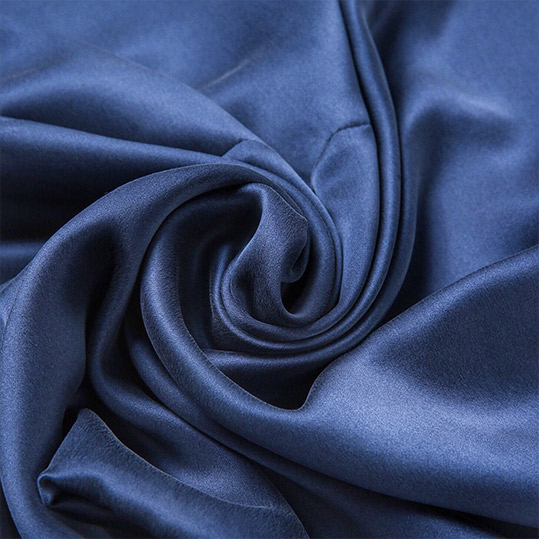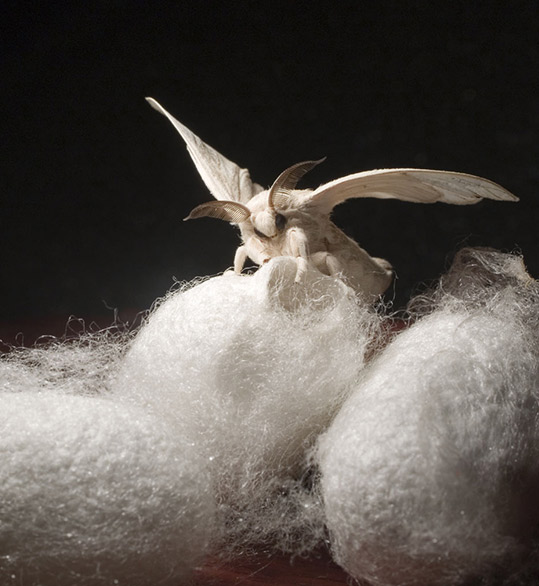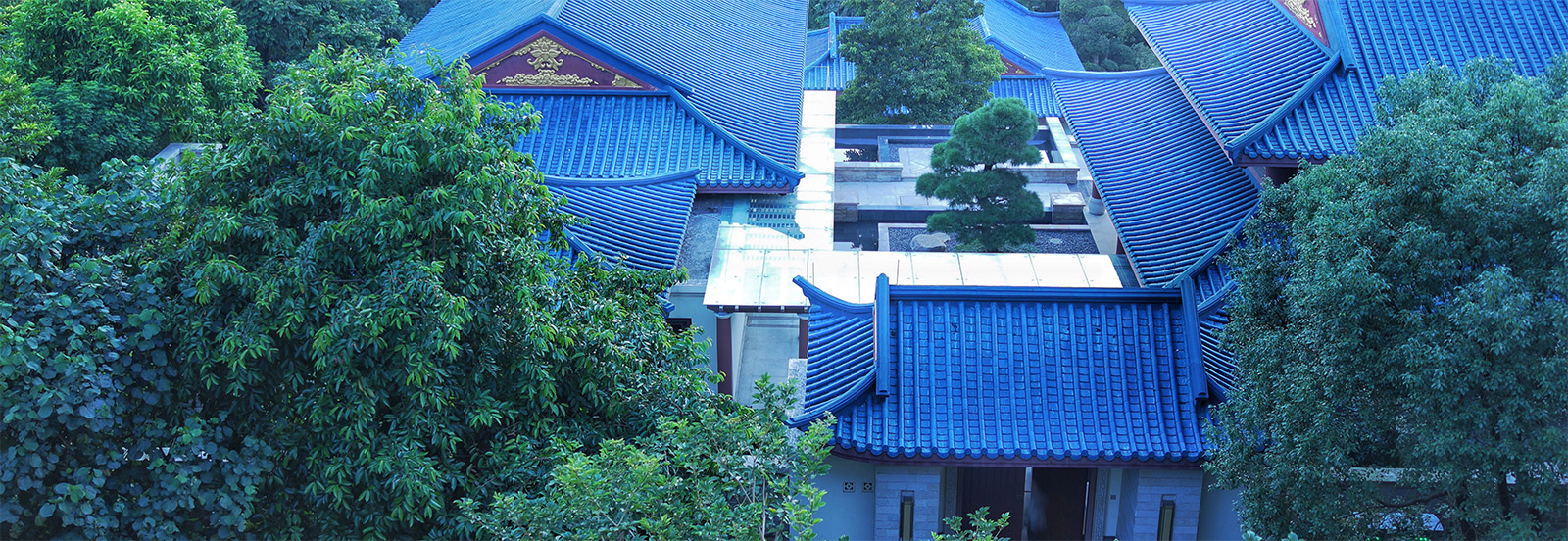The silk fiber is chiefly composed of 80% of fibroin, which is protein in nature and 20% of sericin (silk gum).
Silk is the strongest natural fiber and has moderate abrasion resistance. The strength of the thrown yarns is mainly due to the continuous length of the fiber. Silk is very Strong but lightweight.
Natural luster from its smooth threads, giving beautiful appearance.
Silk has a liability and suppleness that, aided by its elasticity and resilience, gives it excellent drapability.
Silk is a protein fiber and is a non-conductor of heat similar to that of wool. This makes silk suitable for winter apparel.
Silk fabrics being protein in nature have good absorbency. The absorptive capacity of the silk fabric makes comfortable apparel even for warmer atmosphere. Fabrics made from silk are comfortable in the summer and warm in the winter. Silk fiber can generally absorb about 11 percent of its weight in moisture, but the range varies from 10 percent to as much as 30 percent. This property is also a major factor in silk’s ability to be printed and dyed easily.
Silk won’t irritate sensitive skin. It is actually helps in case of a sensitive skin due to its natural thermostatic characteristics.
Silk fabric does not attract dirt because of its smooth surface. The dirt, which gathers can be easily removed by washing or dry cleaning. It is often recommended for the silk garments to be dry-cleaned. Silk fabrics should always be washed with a mild soap and strong agitation in washing machine should be avoided.

Ladies making silk, early 12th-century painting by Emperor Huizong of Song (a remake of an 8th-century original by artist Zhang Xuan), illustrates silk fabric manufacture in China.
According to Chinese legend, Empress His Ling Shi was first person to discover silk as weavable fibre in the 27th century BC. Whilst sipping tea under a mulberry tree, a cocoon fell into her cup and began to unravel. The empress became so enamoured with the shimmering threads she discovered their source, the Bombyx mori silkworm found in the white mulberry. The empress soon developed sericulture, the cultivation of silkworms, and invented the reel and loom. This is the earliest surviving reference to silk history and for nearly 3 millennia, the Chinese retained a global monopoly on silk production.
Initially first reserved for Chinese royalty, silk spread gradually through the Chinese culture both geographically and socially. From there, silken garments began to reach regions throughout Asia. Silk rapidly became a popular luxury fabric in the many areas accessible to Chinese merchants, because of its texture and lustre.
During the later half of the first millennium BC, demand for this exotic fabric eventually created the lucrative trade route now known as the Silk Road, taking silk westward and bringing gold, silver and wools to the East.
Named after its most valuable commodity, silk was considered even more precious than gold. The Chinese realized the value of this beautiful material they were producing and kept its secret safe from the rest of the world for more than 30 centuries.
By CE200, sericulture had spread to Korea via Chinese immigrants, emerging in India, Japan and Persia around CE300 and reaching Europe around CE550 via the Byzantine Empire. In the 7th century, the Arabs conquered Persia, capturing their magnificent silks in the process. Sericulture and silk weaving thus spread through Africa, Sicily, and Spain as the Arabs swept through these lands. Andalusia was Europe’s main silk-producing center in the 10th century.
By the 13th century however, Italy had gained dominance and entered the hall of fame in silk history. By the 17th Century, France was challenging Italy’s leadership, and the silk looms established in the Lyons area at that time are still famous today for the unique beauty of their weaving.
In Medieval Europe, silk was used only by the nobility.
The nineteenth century and industrialization saw the downfall of the European silk industry. Cheaper Japanese silk, especially driven by the opening of the Suez Canal, was one of the many factors driving the trend as was the advent of manmade fibre, such as nylon which replaced traditionally silk products such as stockings and parachutes.
Japan became the world’s biggest producer of raw silk until China recaptured her position in the 1970’s. Today, around 125,000 metric tons of silk is produced in the world. Almost two thirds of that production takes place in China.
Producing high quality silk (sericulture) is a lengthy, complex process that demands constant close attention and the Chinese have perfected this over the centuries. China is committed to continually elevate its quality by investing in the latest manufacturing machinery.
1/2

Silk is a protein fiber made by silk worms and is the only natural fiber that is a filament fiber.
Originally, it was believed that an ancient Chinese princess was the first to discover the process for manufacturing silk fabric from the filament fiber produced by silk worms. Even though this was considered to be a legend, the first country to manufacture silk fabric was China.
Sericulture (silk farming) is the process used to produce the raw silk filament used create skeins of the fiber. The first step in the process is the harvest of mulberry plants used to feed the silk worm. After the silk worm produces a cocoon, the filament used to produce the fiber is extracted from the cocoon during a process called reeling.
The filament from the cocoon is called raw silk. The second stage in the process of creating silk fabric involves the manufacturing of the raw silk into various forms. The thread is used to weave or knit a variety of clothing and textile related products.
Compared to the world’s total fiber production, silk fibers only make up for under 1%. THIS IS WHY silk is being traded as one of the most precious fibers.
1/2
A silk rope is stronger than an equally thick metal wire.
Half a kilo of caterpillars eats up to 12000 kilograms of mulberry tree leaves In its lifetime.
A silk worm eats 40000 times its own weight's worth of mulberry tree leaves between its birth and its pupating.
The fiber has an average width of 20 µm, (µm = micrometer, i.e. 1 millionth of a meter)
It takes up to 10 kg of cocoons to obtain 1 kg of silk.
One single filament can reach a length of up to 4000m.
It takes more than 25 mulberry trees to obtain 3 kg of silk.
A single silk worm can produce up to 15m of fiber per minute.
The silk worm increases in weight by the factor 12000 within 4 weeks of being born.
The silk worm grows to 25 times its size over the first 4 weeks.
A silk dress requires almost 70 kg of mulberry tree leaves.


Silk can be dry-cleaned, or handwashed in home. More often we take silk clothes to drycleaner, mainly for the reason the silk cloth carries few embroidery or lace on them, to maintain its appearance, we need to dry-clean them, but for those silk clothes without extra accessories or embroidery (e.g. silk shirt, plain silk dress, scarf, pants), we can handwash them in home.
Use a mild soap.
Soak silk in warm water for 3-5 minutes. (If silk is dark or printed, do not let it soak. Just quickly wash it in cold water.)
Gently move the fabric during soaking from side to side. (Do not wring dry!) Handle wet silk with even greater care as it is very delicate.
After a maximum of 5 minutes remove silk from water and rinse the fabric with cold water.
Wrap silk in a dry towel to remove the remaining liquid.
Iron (stream) it from the backside. Must steam by a standing steamer, don’t iron/steam it directly on the fabric, just stream the fabric surface by steamer.
If your home only has a ironer, use a thin towel to cover the fabric, then iron above the towel and set low temperature. Always remember that silk is a protein structure much like human hair. Heat will damage it. Try to iron from the corner to test the fabric effect if you are not sure.
Never spray silk with perfume or deodorant
Never bleach silk
Never expose silk to direct sunlight for longer periods, because silk absorb sunlight, and sunlight will make white silk fabric became yellowish.
High temperature iron on silk .
